

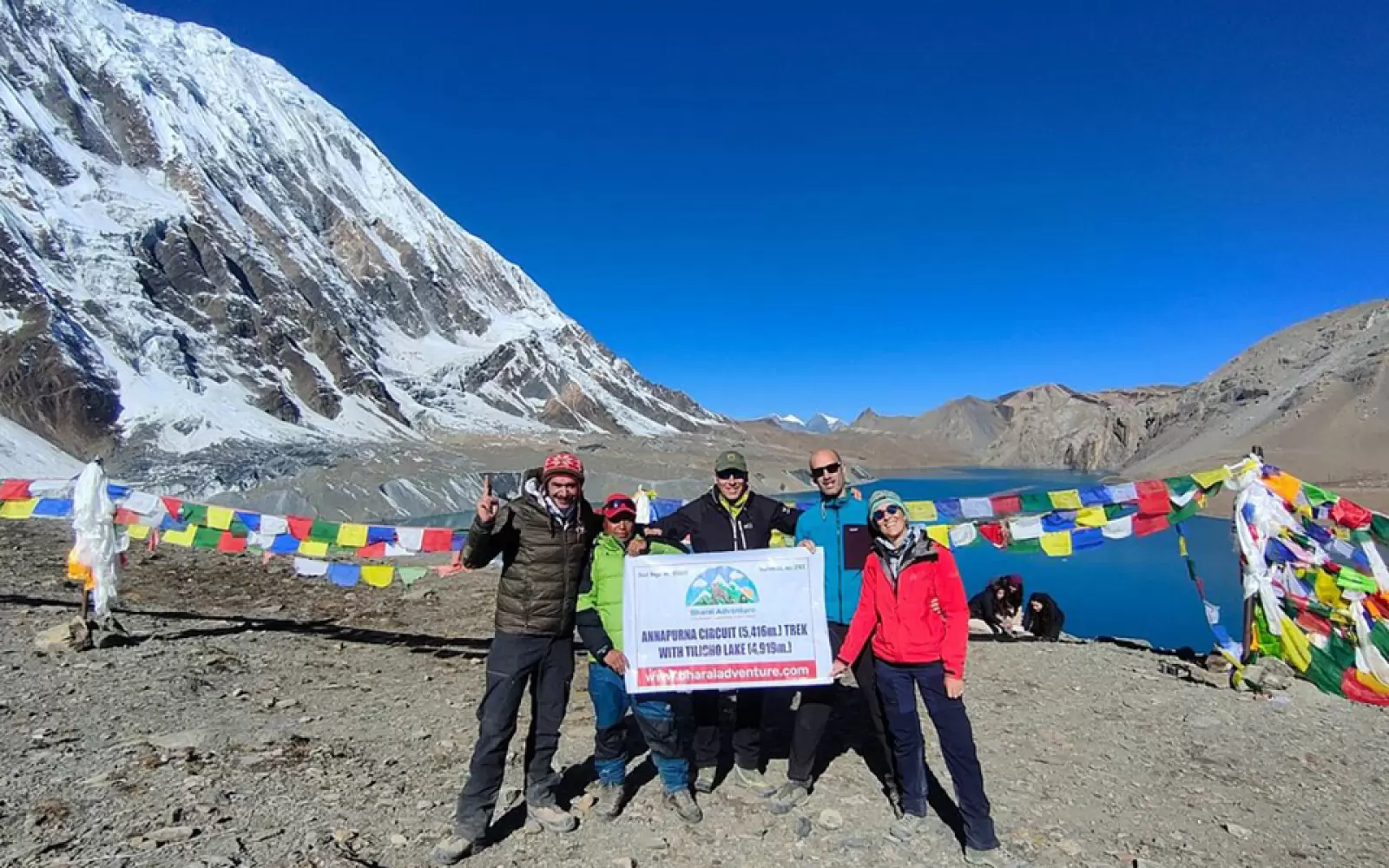
The Annapurna Circuit Trek offers an exciting journey for adventurers who are looking for an adventure where they can witness the beauty of diverse landscapes. The trekkers can explore nature in its purest form during this majestic trek. They can gaze upon alluring Himalayan vistas during this immersive adventure. The trek presents some of the most magnificent mountain scenery taking trekkers to one of the most spectacular regions in Nepal.
This scenic trek passes through incredible destinations such as Pisang, Manang, Muktinath, and Jomson. In addition, the Himalayan vistas seen from Thorong La Pass (5,416m), the highest point of the trek, are phenomenal. The trek takes adventurers through picturesque villages, rivers, dense forests and desert-like terrains which is fascinating.
Annapurna Circuit Trek offers beautiful views of Dhaulagiri, Pisang Peak, Gangapurna, Tukuche Peak, Annapurna IV, Annapurna I, and other nearby mountains. Understanding Annapurna Circuit Weather & Temperature in various seasons is necessary to complete the trek conveniently. Also, being aware of the month's weather pattern allows the trekkers to plan the trek better which allows them to have a secure and delightful trekking experience. Selecting the right season for the Annapurna Circuit Trek makes the trek a successful, safe, and enjoyable one that adventurers will remember for a lifetime.
Annapurna Circuit Weather & Temperature: Month by Month
January, the second winter month is the coldest with snowfall, and extremely low temperatures, particularly at higher elevations. Even though the weather is very cold, January offers a unique trekking experience for adventurers who wish to trek in solitude amidst beautiful snow-covered scenery. As there are fewer trekkers, the peaceful ambiance of this month allows trekkers to connect with nature deeply.
The clear and cloud-free skies provide breathtaking views of the snow-clad peaks. The daylights are shorter and night hours are longer this month. The day temperatures in the lower areas of the circuit are between 10°C and 12°C, and night can be 0°C or below. As the elevation gets higher, the daytime temperature fluctuates between 1°C to -10°C, while at night it drops between -10°C and -20°C.
Trekkers need to be cautious during January trekking. This month is rewarding but also has some notable challenges. The heavy snowfall can make trails slippery. The high pass areas like Thorong La Pass may be challenging to navigate or impassable. So, it is wise to check the weather and ensure accommodation availability. Likewise, trekkers must inquire about trail conditions before heading out for the trek this month. The icy trails at high altitudes demand equipment like crampons and ice axes. Thus, trekkers must ensure adequate preparation for a secure, successful and enjoyable trek in this month.
The month of February marks the end of winter and towards the end, trekkers can observe a combination of winter and spring. Despite the cold, February offers a delightful experience for trekkers. The enchanting views of snow-covered peaks can be seen during this time and the quieter trails provide a peaceful trekking experience.
With fewer trekkers around, the adventurers can connect more deeply with nature. Like with the rest of winter, the days are short and the nights are long. The initial period of the month is extremely cold, especially in higher areas. The temperatures along the Annapurna Circuit range from -1°C to -10°C, with the higher ranges being even colder with nighttime temperatures dropping as low as -14°C.
The icy and snowy trails can be difficult to navigate when temperatures are more colder. So, warm clothing is essential for comfort and safety. Warm clothing such as thermal wear, sturdy boots, insulated jackets, and gloves are essential. February can be a very rewarding month for Annapurna Circuit Trek, with beautiful scenery and a peaceful ambiance for those for those who can handle cold conditions in the Himalayas.
March marks the arrival of the vibrant spring season and is one of the most favored months to trek the Annapurna Circuit. At this time, the lush scenery and flower filled trails attract many visitors. The blooming rhododendrons make the whole surrounding colorful. The skies are clear and you can witness the unobstructed beauty of mountain vistas. You can capture the magnificent snapshots of the Annapurna mountain ranges from different vantage points.
The weather is ideal for exploration this month. The cold winter gradually disappears and the area gets warmer. The weather is mild with minimal possibilities of adverse conditions like heavy snow or downpours. The atmosphere is pleasant with the cool breeze. In the high altitude areas, the weather is on the colder side.
Temperatures can range between 4°C to -5°C during the day and night temperatures can drop up to -8°C or more. It especially gets chilly in the mornings and nighttime. So, warm clothes are essential. Thus, March is a good month for trekking and provides an excellent experience rewarding trekkers with exceptional scenery and favorable weather and trail conditions.
The spring of April is considered one of the best times to do Annapurna Circuit Trek. With warm and sunny days and clear weather, the trekkers will have a pleasant experience opting for the journey this month. The cloudless skies, moderate weather, and uninterrupted views of alluring landscapes make this time optimal for trekking. Likewise, there are endless opportunities for photography during this season. The vibrant rhododendron and other Himalayan wildflowers add to the beauty of the hillsides and forested section.
The moderate weather makes this month a favorite of many trekkers, and thus the region gets more visitors during this month. Trekkers can have an interactive journey this month being accompanied by trekkers from around the world. The trails are well-defined and perfect for navigation with a pleasant spring ambiance.
At the lower elevations, daytime temperatures are between 16°C and 20°C. In higher areas, the temperature at day time can be 5 °C to 8 °C and at nighttime it can range between 0°C and -5°C. Therefore, layered clothing is essential to prepare for the changing conditions. Trekkers can ensure an enjoyable journey in this month gazing upon the wonderful spring sceneries without worrying about the weather-related challenges.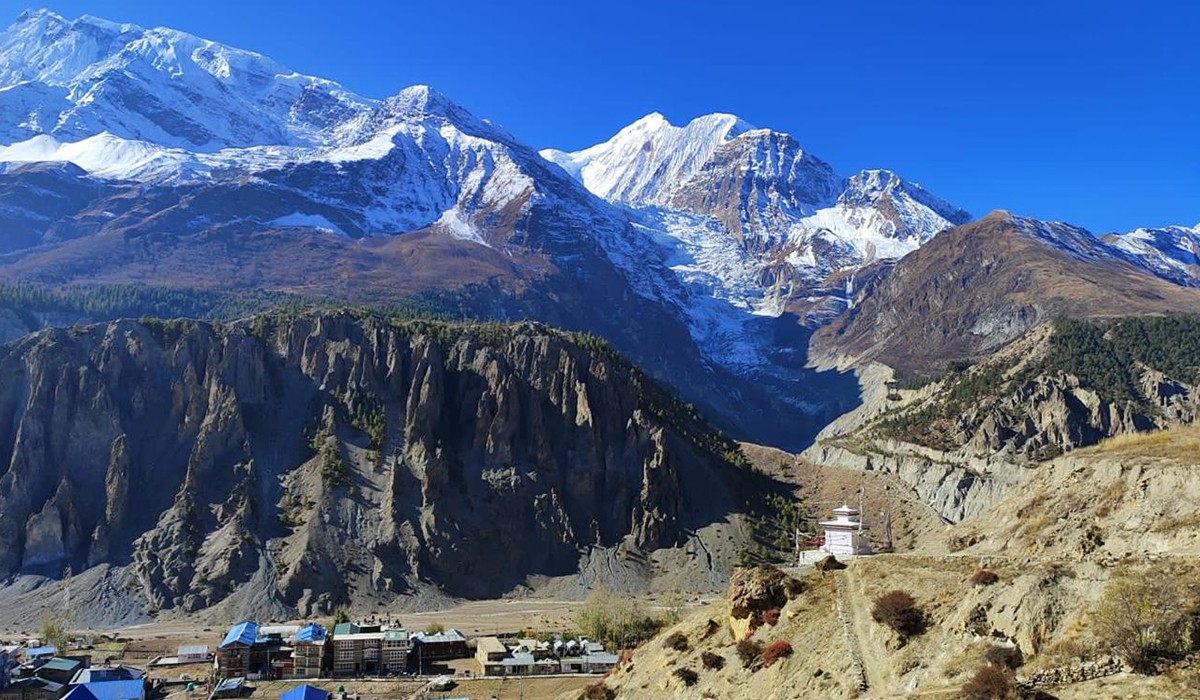
May is the end of the spring season in Nepal. However, the weather is favorable for trekking and exploring the beautiful Himalayan areas this month. The weather is pleasant on most of the days. At the end of the month, there can be light rainfall. So, trekkers must pack waterproof jackets, boots, and trousers for trekking this month.
However, for the initial days the weather is clear and quite warm. Trekkers can witness spectacular views of the Himalayan summits. In addition, the month provides ideal conditions for photography and sightseeing. The daytime temperatures in the lower areas range from 18°C to 20°C while at the higher zones, the temperature can be around 5°C to 10°C . At night, the temperature can range from 5°C to 0 °C at the higher zones.
The month is renowned for its alluring beauty. The hillsides are blanketed with wildflowers, which look ethereal against the backdrop of the snowy mountains. The daylight hours are longer. So, trekkers will have more time to enjoy the scenery. This spring month presents the perfect combination of pleasant weather, stunning landscapes and beautiful scenery. This ideal blend makes it an excellent time for Annapurna Circuit Trek.
June marks the beginning of the Summer/ Rainy Season. This season brings increased humidity and heavy rainfall. The trails can be slippery and muddy during this month after the downpours. The weather during this month is unique and unpredictable, as rainfall at occur at any moment. Only a few trekkers join the trek during this time, so the trails this month are serene.
One of the notable attractions of trekking to Annapurna Circuit Trek in June is the greenery. The rains nurture the landscapes and present vibrant scenery. In the clear morning, especially after rainfall in the evenings, the most distinct scenery of mountain vistas can be seen.
The daytime temperatures in the lower regions are 20°C to 25°C. As you go higher, the temperatures range around 10°C to 15°C, providing a cooler, more pleasant environment for trekking. Likewise, in more alpine areas the temperature can dip up to -5 °C. To ensure a secure journey during this month, you need to be fully equipped with rain gear, trek with licensed guides, monitor the weather, and be adaptable to your schedule.
July is the peak period of the monsoon season in Nepal. The weather in the lower areas is quite humid. At this time there are heavy rains on the trails and Annapurna Region presents lush green scenery. There are beautiful wildflowers along the trails in this month.
However, there are also notable challenges like slippery trails and reduced visibility, because of the rain and clouds. Another major difficulty of this month is the presence of leeches along the trail in forest areas which can be very unpleasant for the trekkers.
July has day temperatures ranging from 18°C to 25°C in low altitudes. However, at night time it gets cooler with temperatures dropping up to 6°C or even lower at higher elevations. The rains cool down the environment, and higher regions are mostly cold. Thus, rain gear and layered warm clothing is necessary.
One of the advantages of trekking in July is its serenity. Fewer trekkers on the route mean that you can have a peaceful trekking experience. In addition, the green landscapes, and beautiful clouds floating in the sky offer an exhilarating experience. If you can tackle the hardships of the monsoon season then with a well-planned itinerary, proper preparations, and gear you can have a smooth trekking experience in July.
August is the final month of the monsoon/ summer season. This month also receives rainfall, especially in the initial days and rain clouds can be seen in the sky which can obstruct visibility. This month presents challenges similar to those of June and July like slippery trails, unpredictable weather, and presence of the bugs and leeches. However, as the month advances, the heavy rains disappear gradually. Though there may still be periodic showers, the skies begin to clear up and mountain vistas become more visible.
One of the prominent highlights of trekking in August is the beautiful green landscape. The terrains are decorated with green grass, and vibrant wildflowers offering marvelous scenery. In addition, the views of waterfalls are stunning this month. As fewer people venture on the path during August, the trekkers can enjoy a more tranquil and calm experience.
The daytime temperature ranges from 19°C to 25°C at the lower section of the trails. However, it decreases as you move to higher areas ranging from 5°C to 10 °C with the possibility of dropping further lower during nighttime.
Trekkers should be prepared for wet and slippery trails with durable rain gear for a more comfortable and secure journey during this month. The challenges presented by this month should be highly considered and should not be overlooked. However, with adequate preparation, this time can be one of the most delightful and serene times for Annapurna Circuit Trek.
The transition to the delightful autumn season begins in September. In this month the weather is delightful, with moderate temperatures and clear skies which is perfect for trekking. During this month the days are usually bright and clear with beautiful views of the Himalayas.
This is the first post-monsoon month, so the atmosphere is still fresh and green with nourished landscapes. Though there are chances of light rainfall at the beginning of the month. As the month progresses, the rainfall fades away and the weather will be more stable. The autumn's fresh and refreshing wind takes over the Annapurna Region and makes the journey more pleasant and rejuvenating.
The daytime temperatures in lower altitudes vary between 15°C and 20°C, which is perfect for trekking. Nights are generally cold, especially in the higher zones with temperatures dropping between 0°C to 5°C. Thus, trekkers must pack warmer clothes for the cooler nights. As the day progresses, the weather becomes more pleasant with clearer skies and bright sunshine. The clear skies of September offer beautiful views of snowy peaks. In addition, the moderate weather rewards trekkers with an unforgettable adventure.
The delightful October is considered an ideal time for the Annapurna Circuit Trek with dry and stable weather. The sky in this month is mostly clear each day, providing a great view of the snowy mountain panoramas. The favorable weather with no heavy snow showers and rain ensures firm and well-defined trails, which makes trekking relatively easier.
With exceptional visibility and crisp autumn air, you will have a joyful trekking experience.
In the lower regions, the day temperatures range from 14°C to 20°C. With rising altitude, the temperatures can drop significantly, at night. The upper altitude areas temperature at night time can range between 5 °C to 0 °C.
The high-altitude pass of the region which is Thorong La Pass is even colder. So, wearing warm, thick clothing is essential for a comfortable journey at higher elevations. October is a peak trekking month with many trekkers. The striking mountain views and vibrant surroundings make Annapurna Circuit Trek an experience that you will cherish for a long period.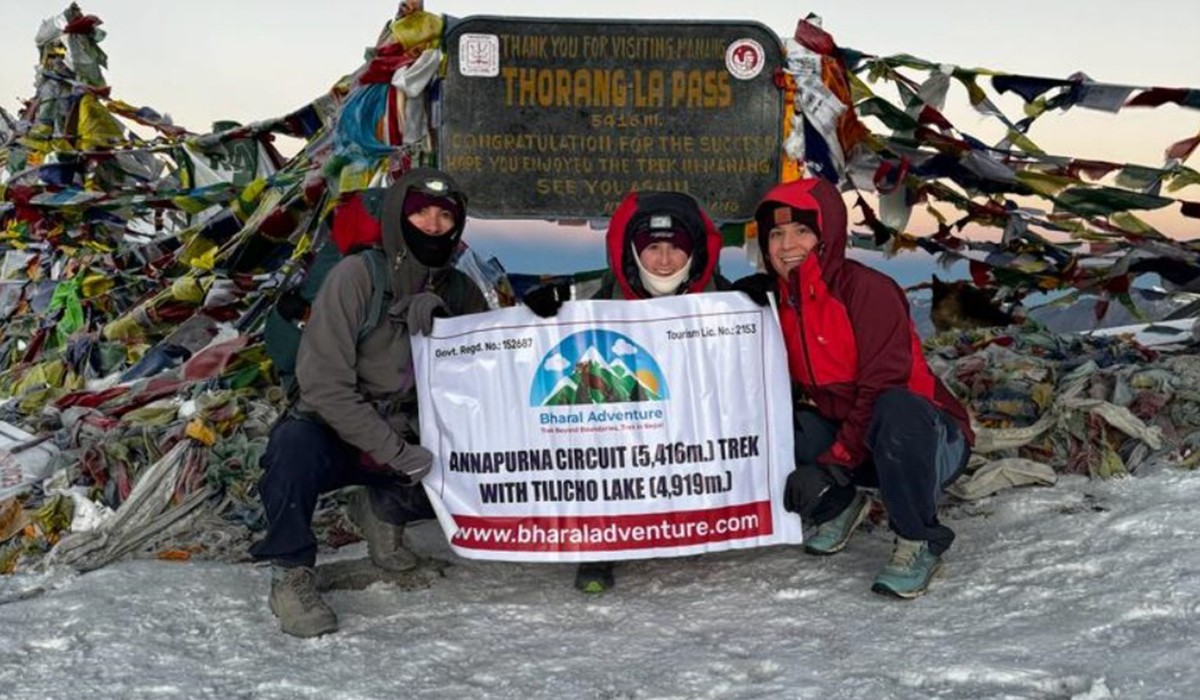
November signals the end of late autumn and the beginning of early winter in the Annapurna region. With steady weather, it is another fantastic month for the Annapurna Circuit Trek.
Trekking in November rewards you with clear blue skies and alluring mountain views. With very little likelihood of heavy rain or snowfall, you will have a hassle free trekking experience, especially during the early days. While trekking conditions are stable throughout most of November, colder weather begins to set in toward the month's end. Thus, you should be well prepared with warm clothing.
The fresh autumn air and the clear weather with fewer clouds contribute to the spectacular vistas, making it a wonderful time for a scenic trek. The weather is cooler during the day, ranging from 5°C to 12°C at the lower altitudes. At higher zones, the temperature is lower, even reaching down to 0 °C to -5 °C at night.
The winter approaches at the end of the month but skies are mostly clear with great visibility. The views are distinct and trails are perfect to navigate. As the month progresses, the days are shorter with colder nights. So, it is necessary to plan well to have a secure, delightful and enjoyable trekking experience in the Annapurna Region.
December is the first winter month. In this month, the mountains are covered with snow and there are very few chances of downpours. During this month Annapurna Circuit's trails are peaceful as there are fewer visitors. The weather is generally dry this month, and the temperature keeps falling as the month progresses.
The trails at higher zones get snow showers in and trekkers can witness the ethereal winter wonderland. The breathtaking views of snow-covered mountains and a peaceful environment offer the most scenic trekking experience. However, the snowy trails and low temperature bring challenges too. The icy and snowy trails can be harder to navigate requiring proper caution and advice from the expert guides.
The daytime temperatures ranging from 0°C to 10°C are usual in lower regions. However, temperatures may fall as low as 0 °C to 5 °C at the time and drop up to -10°C in higher areas, during the night. As December progresses the nights grow colder, with temperatures below freezing. Thus, to remain warm and secure, it's essential to bring sufficient warm clothing and dependable trekking gear.
Trekkers should know about the weather's unpredictability, check the forecasts and be careful while trekking. While there are certain challenges to trekking Annapurna Circuit during December, it has unique advantages. There are fewer crowds on the trails. So, trekkers can have the opportunity to connect with nature.
In addition, they can observe the stunning winter landscape. If you are planning to trek this month then you should be well equipped with winter gear. Likewise, you should be flexible with your itinerary for a secure experience.
Every season has its charm. However, Spring and Autumn are the ideal seasons to undertake this trek. During Spring months (March to May) you can trek in the Annapurna area while being mesmerized by blooming rhododendrons, and other wildflowers. The climate is stable, and trails are well defined which makes trekking at high altitudes less strenuous. If you prefer seeing beautiful vistas, feel fresh mountain air, and wish to trek in the moderate weather then spring is an ideal time to embark on the journey.
Autumn (September-November) is another favorable time for the Annapurna Circuit Trek. During this time the skies are clear. You can gaze upon the mesmerizing views of the snowy mountains. The air is crisp and the visibility is exceptional, providing you with the best sightseeing experience. The temperatures are mild with dry trails. So, it is the best time to opt for Annapurna Circuit Trekking with fellow adventurers and immerse in the tranquility of the mountain vistas.
Winter trekking from December to February can be a magical experience for the adventurers. The snow covers the high altitude terrain. The winter landscapes are stunning. The trails are peaceful with fewer visitors. However, it is important to note that Thorong La Pass and other high altitude trails may be impassable due to heavy snowfall. So, trekkers should check trail conditions beforehand. If you are well-equipped with proper gear and can handle subzero temperatures, winter trekking will provide you with a distinct and peaceful experience.
Monsoon Season (June to August) transforms the Annapurna region into a beautiful paradise. The beautiful waterfalls flowing over the hills and lush greenery are the major highlights of this season. However, the downpour makes the trails slippery and there may be leeches in the forested area.
Furthermore, the clouds and foggy skies can obstruct the views. There is also the likelihood of landslides because of the heavy downpours. While the scenery is unique and clear days offer stunning views of Himalayan landscapes, proper preparation and adaptability of schedule are required to trek in this season.
● Lightweight, moisture-wicking Thermals (top and bottoms)
● Fleece Jackets
● Warm Down Jackets
● Waterproof Jackets
● Rain jackets and pants
● Trekking pants
● T-shirts
● Hats
● Gloves
● Scarf
● Beanie
● Trekking socks
● Rain gears
● Windproof Jackets
● Sunhats
● Long-sleeve shirts
● Waterproof Trekking Boots
● Warm Thermal base layers
● Beanie
● Insulating Down Jackets
● Warm trekking pants
● Woolen socks
● Sleeping bag (High Quality)
● Sweaters
● Balaclava
● Long-sleeve shirts
● Scarf
● Fleece jackets
● Crampons and ice axes
● Warm Gloves
● Warm Caps/ Hats
● Fleece Jackets
● Sturdy Trekking Boots
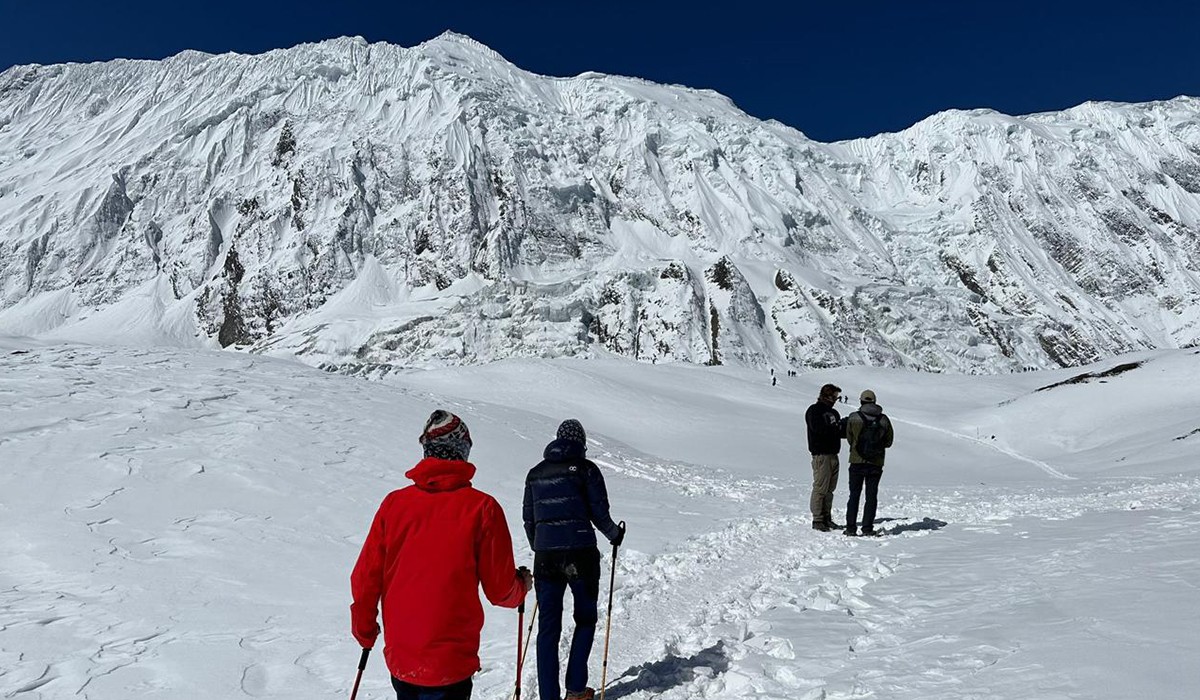
● Waterproof Rain Jacket and Pants
● Lightweight Thermals
● Windproof Jackets
● Lightweight insulated Jackets or Fleece Jackets
● Light Gloves
● Insect repellent
● Moisture-wicking t-shirts
● Neck gaiter
● Waterproof Trekking Pants
● Liner socks
● Lightweight Sport Shoes
● Anti-leech socks
● Sun Hats
● Backpack cover for rain protection
● Waterproof Trekking Boots
● Hiking Boot Gaiters
● Rain Poncho
● A Daypack
● First Aid Kit (Bandages, paracetamols, anti-diarrheal, painkillers, etc)
● Trekking Poles
● Reusable Water Bottle
● High Energy Snacks
● Trekking Route Map
● Water Purification Tablets
● Soap (Biodegradable)
● Sunglasses
● Suncream
● Lip Balm
● Flashlights
● Sleeping Bag
● Trekking Permits and Identification Documents
● Rain Gears
● Towel
● Hair Comb
● Tissues
● Hand Sanitizer
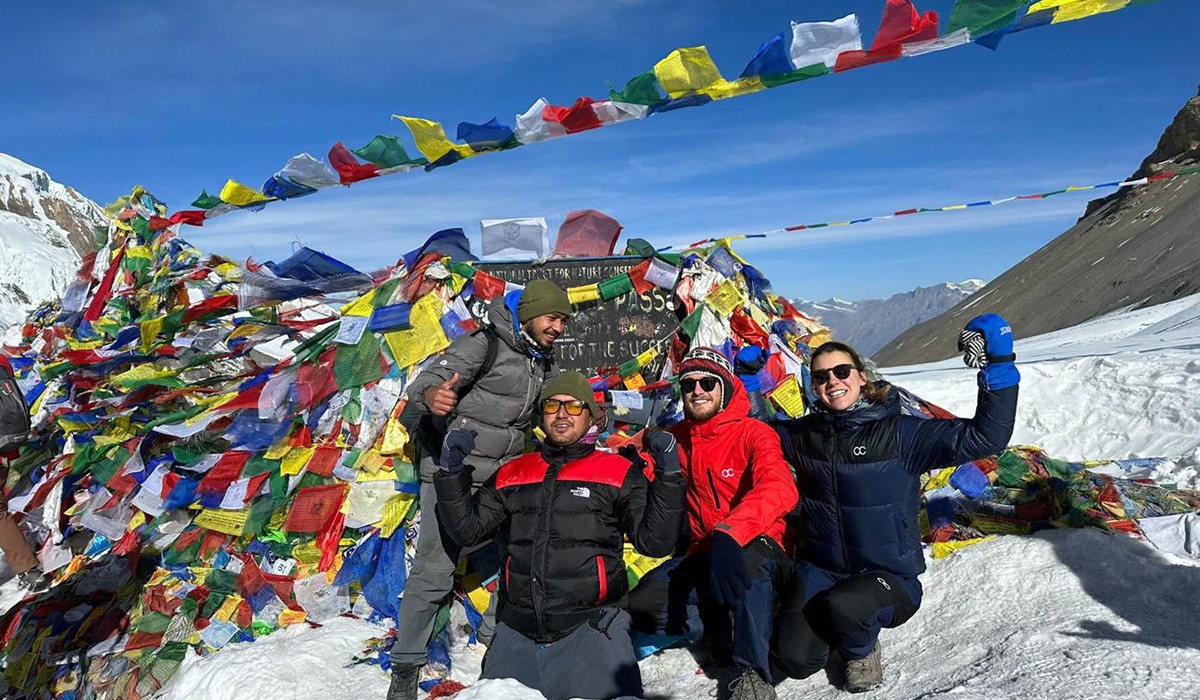
● Acclimatization is essential for all seasons. So, make sure to include days for rest and acclimatization, take the required rest, trek gradually, hydrate yourself with lots of water, and have balanced meals to minimize the risk of altitude sickness.
● Walk only through the marked trails.
● Check the weather forecast before heading out on each day.
● Inquire about the accommodation availability in the off seasons (Summer/ Monsoon and Winter).
● Book the trek package or accommodation early especially in peak seasons (Spring and Autumn) as they get reserved quickly, especially at the popular stops in the Annapurna Region.
● For winter trekking, pack warm clothes. Watch out for snowy paths. Invest in high quality trekking boots.
● Rain jackets, quick drying clothes and backpack covers are a must in the monsoon for staying dry. Likewise, make sure to wear sturdy trekking boots and carry insect repellent for this season.
● In spring and autumn, lightweight layers are preferable. However, the higher zones are mostly cold. So, makes sure to dress in layers as they offer versatility and you can adjust clothes according to temperature changes. Generally, mornings and evenings are cool, but the days may be warm and sunny during these seasons.
● Mountain weather is very unpredictable. So, make sure to bring all trekking essentials and extra sets of warm clothes, snacks and a first aid box.
● Make sure to trek with local guides and porters from registered trekking agencies.
● Be flexible with your trekking itinerary. It may need adjustments because of the weather or any other unforeseen circumstances.
